
David : Son of Jesse : Father of Solomon : King of Israel. David is probably the most famous character in the Hebrew Bible. But did he actually exist? That is what we will be investigating in this article.
David’s story is recounted mainly in I & II Samuel, I Kings, and I & II Chronicles. He is also mentioned in Ruth, II Kings, Ezra Nehemiah, Psalms, Proverbs, Ecclesiastes, Song of Songs, Isaiah, Jeremiah, Ezekiel, Hosea, Amos, and Zechariah. His story is too well known to repeat here, and too long to summarize.
The Name David
In the Bible the Hebrew name Dawīd is spelt in two different ways (Strong 30):
דוד [dwd]
דויד [dwīd]
The former defective spelling is found in Samuel and the older books of the Bible. The latter plene spelling is found in Chronicles and the later books. The name is believed to derive from a Hebrew root meaning to love (Orr 790 : Strong 30). The defective spelling is used elsewhere in the Bible with a slightly different vocalization to mean beloved or well-beloved (Strong 30). It has also been suggested that the name was a title―perhaps a throne name―and not a personal name (Freedman 1842).
Is it significant that one of the Biblical names of David’s son and successor Solomon was Jedidiah, which has been interpreted as beloved of Yahweh (Freedman 2088)? In texts from the Canaanite city of Ugarit ydd, Beloved [of El], is an epithet of the local god of death Mot (Freedman 4201). The similarity of the two names has been noted by Biblical scholars (Freedman 4202).
David the son of Jesse is the only person in the Bible who bears this name.
It has also been noted that it is not only in the spelling of Dawīd that Chronicles differs from the older books of the Bible. The account of David’s life and reign in I Chronicles only strengthens the links with Solomon:
The salient features of the life and reign of David as outlined from I Sam. xvi. to I Kings ii. have been given above; and the most incisive criticism has been unable to modify any essential point of the narrative, which rests upon a strictly historic foundation. A far different impression of David is given in I Chronicles. Everything doubtful and offensive in regard to David and his house is here passed by, and he himself appears primarily as being preoccupied with the organization of the Temple service. He is said to have gathered together all the material for the building of the Temple, and to have planned every detail, so that Solomon merely had to carry out the work. (Singer 457)
Were David and Solomon originally one and the same?

David and Hebron
Before he captured Jerusalem and made it his capital David reigned as King of Judah in Hebron, which lies about 30 km south of Jerusalem. David is said to have reigned in Hebron for seven years, while Saul’s son Eshbaal reigned as King of Israel in Mahanaim.
Is it possible that David―insofar as there may be some historical basis to his story―was originally a local Canaanite ruler of Hebron?
The City of David
According to the Hebrew Bible Joshua’s Conquest of Canaan was incomplete. There remained some pockets of Canaanites who were not dispossessed until much later:
As for the Jebusites the inhabitants of Jerusalem, the children of Judah could not drive them out; but the Jebusites dwell with the children of Judah at Jerusalem unto this day. (Joshua 15:63)
David is credited with the conquest of the Jebusite citadel. In I Chronicles we read:
And David and all Israel went to Jerusalem, which is Jebus; where the Jebusites were, the inhabitants of the land. And the inhabitants of Jebus said to David, Thou shalt not come hither. Nevertheless David took the castle of Zion, which is the city of David. And David said, Whosoever smiteth the Jebusites first shall be chief and captain. So Joab the son of Zeruiah went first up, and was chief. And David dwelt in the castle; therefore they called it the city of David. (I Chronicles 11:4-7)
The Hebrew expression עיר דוד [Īr Dawīd], City of David, is variously used to refer to:
- The Jebusite Citadel of Zion
- Jerusalem
- The burial ground of several Judean kings
A term appearing in the OT which refers both to the Jebusite “Stronghold of Zion” (mésudat siyyon), captured, occupied, and renamed by David (2 Sam 5:6–9), and to the burial ground in which at least nine Judean kings were interred (e.g., David, 1 Kgs 2:10). In modern usage it is largely a historical-geographical term denoting that part of Jerusalem inhabited during the time of David. (Freedman 1858)

It is probably safe to assume that this name was applied to Jerusalem when it passed from the Jebusites to the Judahites. As the city grew, the meaning of City of David came to be restricted to the old city.
Jerusalem itself is named for the Canaanite god of dusk Shalem:
The name “Jerusalem” (Heb yerusalayim) is of uncertain etymology, although it is apparently of W Semitic (Canaanite) origin. It appears to be composed of the two elements: yrw “to establish” and šlm, the name of the W Semitic god Shalem, patron of the city. The meaning may be “foundation of (the god) Shalem,” mentioned in a mythological text from Ugarit. Gen 14:18 refers to Melchizedek as king of Salem (Heb salém), likely Jerusalem. If so, this shortened form is the first biblical allusion to Jerusalem. In Psalm 76:3 (—Eng 76:2) Salem is used in synonymous parallelism to Zion, referring to the divine dwelling. (Freedman 4327)
If City of David was originally a synonym for Jerusalem, does this mean that David and Shalem were one and the same deity? Note that I Chronicles 11 actually credits David’s nephew Joab son of Zeruiah with the capture of Zion.
David the Musician
In I Samuel 16 David is first introduced to Saul as a musician:
And Saul’s servants said unto him, Behold now, an evil spirit from God troubleth thee. Let our lord now command thy servants, which are before thee, to seek out a man, who is a cunning player on an harp: and it shall come to pass, when the evil spirit from God is upon thee, that he shall play with his hand, and thou shalt be well.
And Saul said unto his servants, Provide me now a man that can play well, and bring him to me.
Then answered one of the servants, and said, Behold, I have seen a son of Jesse the Bethlehemite, that is cunning in playing, and a mighty valiant man, and a man of war, and prudent in matters, and a comely person, and the Lord is with him.
Wherefore Saul sent messengers unto Jesse, and said, Send me David thy son, which is with the sheep.
And Jesse took an ass laden with bread, and a bottle of wine, and a kid, and sent them by David his son unto Saul. And David came to Saul, and stood before him: and he loved him greatly; and he became his armourbearer ...
And it came to pass, when the evil spirit from God was upon Saul, that David took an harp, and played with his hand: so Saul was refreshed, and was well, and the evil spirit departed from him. (I Samuel 16:15-23
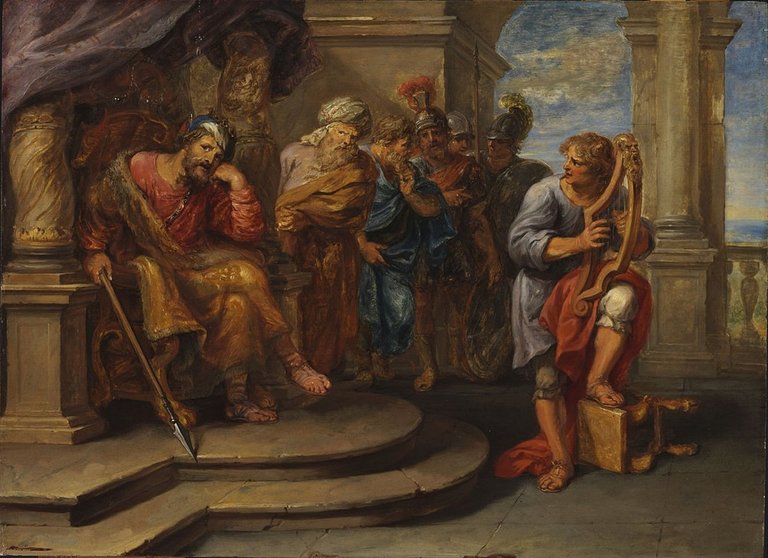
David is also traditionally credited with composing the Psalms. What is the significance of all this? Why are his musical abilities emphasized?
In Greek mythology the lyre is associated with several deities. Hermes is credited with inventing it by stretching strings across a tortoise shell. He gave it to Apollo in compensation for fifty cattle he stole from him. Apollo became an accomplished musician on the instrument, but later bequeathed it to his son Orpheus, whose virtuosity on the instrument became legendary. But whether any of this sheds any light on the Biblical account of David’s prowess on the harp―kinnor―I cannot say.
Giant Slayer
One of the most popular episodes in the Bible is that of David and Goliath. The story of a young hero slaying an evil giant is a trope common to many mythologies and folklores. Jack the Giant Killer is still a favourite children’s tale, and in Irish folklore we have the story of Finn MacCool slaying the Scottish giant Benandonner, who constructed the Giant’s Causeway so that he could invade Ireland. This giant-slayer archetype has been interpreted in various ways. Joseph Campbell saw in these tales an expression of the conflict between the old nomadic existence of our hunter-gatherer ancestors and the settled, “civilized”, culture of the Neolithic agriculturists who succeeded them:
I do not know of any myth that represents more clearly than this the crisis that must have faced the societies of the Old World when the neolithic order of the earth-bound villages began to make its power felt in a gradual conquest of the most habitable portions of the earth ... And if we turn our eyes to the mythologies of the Hindus, Persians, Greeks, Celts, and Germans, we immediately recognize, in the well-known, oft-recited tales of the conquest of the titans by the gods, analogies to this legend of the subjugation of the shamans by the Hactcin [Apache gods]. The titans, dwarfs, and giants are represented as the powers of an earlier mythological age―crude and loutish, egoistic and lawless, in contrast to the comely gods, whose reign of heavenly order harmoniously governs the worlds of nature and man. The giants were overthrown, pinned beneath mountains, exiled to the rugged regions at the bounds of the earth, and as long as the power of the gods can keep them there the people, the animals, the birds, and all living things will know the blessings of a world ruled by law. (Campbell 238-239)

The implication is that David, the hero who slays a giant, is a god, not a man. This interpretation is supported by the alternative account in II Samuel, in which several giants are slain:
Moreover the Philistines had yet war again with Israel; and David went down, and his servants with him, and fought against the Philistines: and David waxed faint. And Ishbibenob, which was of the sons of the giant, the weight of whose spear weighed three hundred shekels of brass in weight, he being girded with a new sword, thought to have slain David. But Abishai the son of Zeruiah succoured him, and smote the Philistine, and killed him ... And it came to pass after this, that there was again a battle with the Philistines at Gob: then Sibbechai the Hushathite slew Saph, which was of the sons of the giant. And there was again a battle in Gob with the Philistines, where Elhanan the son of Jaareoregim, a Bethlehemite, slew the brother of Goliath the Gittite, the staff of whose spear was like a weaver’s beam. And there was yet a battle in Gath, where was a man of great stature, that had on every hand six fingers, and on every foot six toes, four and twenty in number; and he also was born to the giant. And when he defied Israel, Jonathan the son of Shimeah the brother of David slew him. These four were born to the giant in Gath, and fell by the hand of David, and by the hand of his servants. (II Samuel 21:15-22)
The King James Version’s brother of Goliath accords with the account in I Chronicles 20:5, but other translators omit the words the brother of when translating II Samuel 21:19. A grammatical explanation of this discrepancy is given on KJV Today.
By all accounts Goliath was a Philistine. In an earlier article we saw that conflict between the Israelites and the Philistines probably took place in the Persian period, much later than the time frame given in the Bible. If David lived in the days of the early monarchy, there would not have been any Philistines in Canaan for him to slay. If there is any historical basis to the story, it belongs to a time long after that of David.
The Tel Dan Stele
The archaeological site of Tel Dan (Tell el-Qadi), which lies at the foot of Mount Hermon, has been identified with the ruins of Dan, the northernmost city of Ancient Israel. The original name of the city was Laish, and it is under that name that it is sometimes mentioned in the Bible (eg Joshua 19:47, Judges 18:29). It was renamed after the Israelite Tribe of Dan, in whose territory it stood.
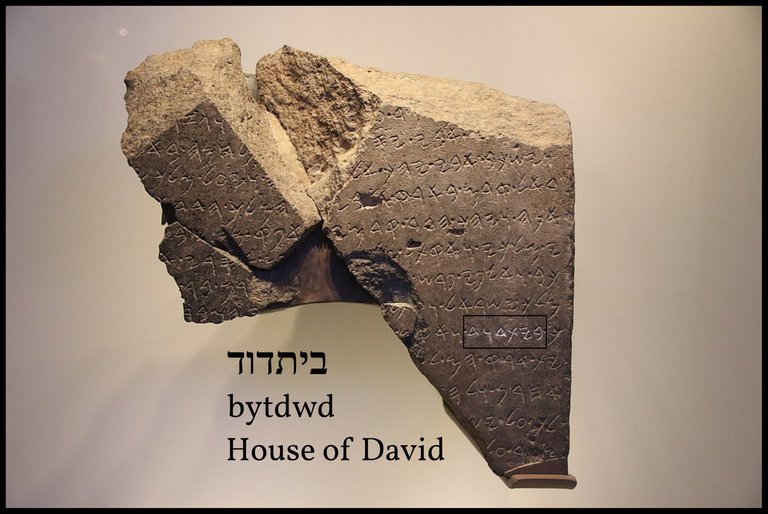
The Tel Dan Stele is a fragment of a stone monument on which a Canaanite inscription has been partially preserved. It was discovered at Tel Dan in 1993 by a member of the archaeological team lead by Avraham Biran. The fragmentary text of this stone is written in alphabetic Aramaic and mentions the House of David, Jehoram King of Israel, and Ahaziah son of Jehoram. The authenticity of the stele has been questioned and the translation disputed, but both are now widely accepted.
Tel Dan has been extensively excavated. In 1963, a short exploratory excavation was carried out by Z Yelvin before Avraham Biran of the Israel Department of Antiquities and Museums (and later Director of the Nelson Glueck School of Biblical Archaeology) embarked upon a remarkable series of excavations spanning thirty-three years (1966-1999). The stele was found between Strata II and III, a layer identified as belonging to the Iron IIB Age. This is the period of the two Kingdoms of Israel and Judah.
The Settlement at Tel Dan persisted throughout the Iron Age. A Phoenician inscription (lb‛t plṭ, “Belonging to Ba‛al Pelet”) is evidence of the latest stratum of occupation at the beginning of the sixth century B.C. When Jeremiah (4:15, 8:16) refers to Dan, he speaks of it as an existing city. (Avi-Yonah & Stern 1:316)
Both the authenticity of the stele and the reading of the inscription have been disputed, but I am happy to accept both. There is archaeological evidence, then, that one of the ruling dynasties in Palestine was known as the House of David. It does not necessarily follow that David was a historical figure. We can only conclude that he was regarded by the members of this family as their ancestor―the Founding Father of their line.
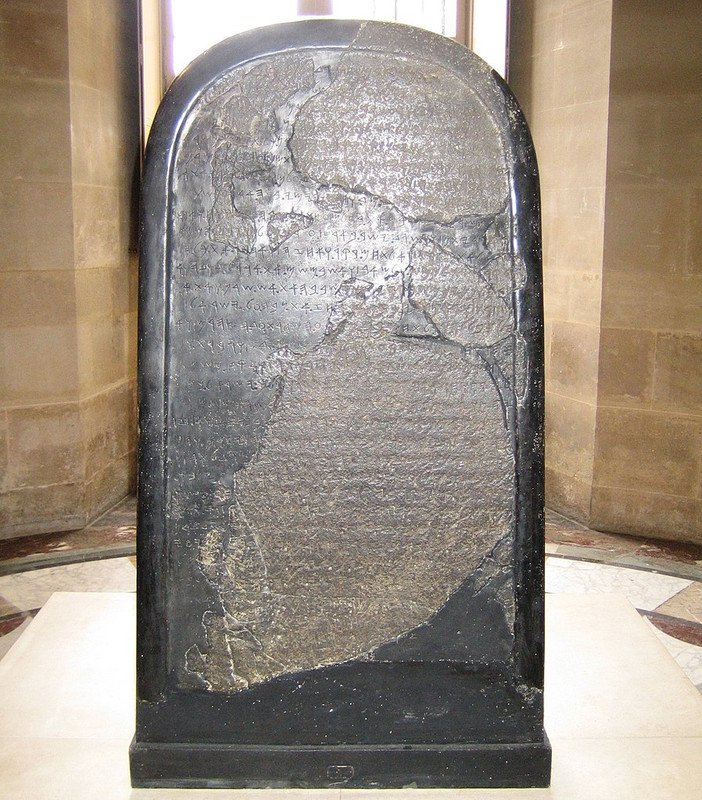
The Mesha Stele
Another piece of archaeological evidence that has often been cited in support of a historical David is the Mesha Stele. The Moabite Stone, as it is also known, is now on display in the Louvre Museum in Paris. It was discovered in 1868 in the ruins of the ancient city of Dibon, which was the capital of the Kingdom of Moab during the reign of Mesha. It is made of basalt, stands about one metre tall, and bears a Canaanite inscription of thirty-four lines. Mesha recounts how Moab was oppressed by Omri King of Israel and his son as a result of the anger of the principal Moabite god Chemosh. He enumerates his subsequent victories over Omri’s son (who is not named). He boasts of his many building projects. He briefly describes his wars against the Edomites in Horonaim. The inscription breaks off here and the concluding lines of text have been lost.
What interests us is the alleged reference to the House of David in line 31. This reading is widely disputed, and the line in question is badly damaged. The French researcher Michael Langlois has argued the case for this reading in Semitica, a review he edits for the Institute of Semitic Studies of the Collège de France in Paris:
At the end of line 31, the best reading―though hypothetical―is בתדוד “Beth-daw‹i›d,” that is, “House of David,” a metonymy referring to Davidic rulers. With the Tel Dan inscription, the Mesha stele might be the earliest historical witness of a ruler named David who, in the ninth century BCE, was remembered as the founder of a Judahite dynasty. (Langlois 47)
Langlois concedes, however, that even if this reading is the correct one and the stele is a genuine artifact from the time of Mesha (a contemporary of Jehoram of Israel) it does not prove the historicity of David:
Of course, such mention of the house or son of David does not solve issues related to the historicity of various biblical traditions regarding David, his kingdom and his dynasty. (Langlois 46)

An Inscription of Shoshenq I
The final piece of archaeological evidence in support of a historical David is an inscription of the Egyptian Pharaoh Shoshenq I, who founded the 22nd Dynasty. In the conventional chronology this dynasty is identified as Libyan and is dated from 943 to 716 BCE, making it contemporary with the rise of the Neo-Assyrian Empire. In the Short Chronology, however, the latter is identified with the Persian or Achaemenid Empire of 550-330 BCE, and the 22nd dynasty comprises Persian vassals:
As a corollary to this, we shall find that the Neo-Assyrian kings from Tiglath-Pileser III onwards were identical to the Persian Great Kings, and that it was these men who brought the Nineteenth Dynasty to an end. We shall find too that the so-called “Libyan” kings, of the Twenty-Second Dynasty, were actually Persian vassals, installed in the Nile Valley by Cambyses and his successors, and that these men, as well as the Nubian kings of the Twenty-Fifth Dynasty, were contemporaries of the last rulers of the Nineteenth Dynasty―Siptah, Tewosre and Seti II, all of whom, as descendants of Ramses II, struggled to reassert Egyptian independence in the early years of the 5th century. (Sweeney 4:15)
This is not a new idea:
The names of the Libyans―Sosenk, Osorkon, Takelot and Nimrot―immediately mark them out as foreign. The supposed Libyan connection is fairly tenuous, to say the least, and is based on the fact that the term “chief of the Ma”―interpreted as chief of the Meshwesh, or Libyans―is a common title of the period. I would suggest however that the name “Ma” is a contraction of Mariyanna, the Iranian nobility. It should be remarked here that no less a person than Flinders Petrie argued at some length for an Asiatic origin, equating Osorkon with Akkadian Sharrukin (“Legitimate king”), Sosenk with Akkadian Shushanku (“Man of Susa”), Nimrot with the Akkadian Nimr (“Leopard”), and Takelot with Akkadian/Assyrian Tukulti (“Helper” or “Trusted One”) [Petrie 231-232]. In the same place Petrie wondered about the origin of the line and stated his belief that “we must look to some Babylonian or Persian adventurer in the service of the Tanite kings for the source of the dynasty.” (Sweeney 4:24)
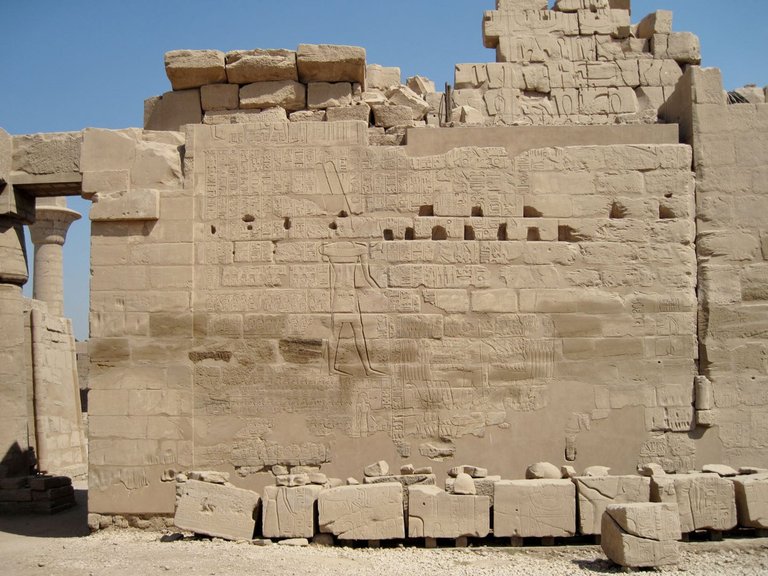
Kenneth Kitchen and numerous other scholars have identified Shoshenq I with the Biblical Shishak, who sacked Jerusalem during the reign of Solomon’s son Rehoboam. But this is untenable:
On the outside of the southern wall of the great temple of Amon at Karnak Sosenk I carved a much-debated list of Palestinian and Syrian cities subject to him. These cities are represented by human figures like those on the nearby bas-relief of Thutmose III, and it is obvious that Sosenk copied the earlier pharaoh’s work. Because of this relief it has been assumed, since Champollion’s day, that Sosenk was the Shishak of scriptural sources who plundered Solomon’s temple in Jerusalem. Apart from the fact that Jerusalem is not even mentioned in Sosenk’s list, one other factor should convince us of the impossibility of such an identification. Among the list of Palestinian towns (very few of which could be identified with known biblical settlements) there was a p’-hw-k-rw’ — ‘b’-r’-m, or Hekel Abram, “the field of Abram.” There are, in fact, quite a few p’-hw-k-rw’, and each of them is identified as hekel, or “field,” in Aramaic. Yet Aramaic, the Semitic dialect of Syria, was not spoken in Palestine until after the Assyrian and Babylonian captivity, when the depopulated land of the Bible was settled by Syrian newcomers. In fact, Aramaic was to become the lingua franca of much of the Near East during the Persian epoch, and the discovery of Palestinian cities bearing Aramaic names on the list of Sosenk is virtually irrefutable evidence that the “Libyan” pharaohs could not possibly predate the Persian Empire. (Sweeney 25)
In the Short Chronology, Shishak was Thutmose III of the 18th Dynasty. I believe that the initial element of this name, sh-sh, is a Hebrew transcription of the Ancient Egyptian form of Thoth, the first part of Thutmose III’s name, which is represented by the hieroglyph of the ibis bird. In modern texts the Ancient Egyptian name of this bird is transcribed as Ḏḥwtj―however that might have been pronounced. If the Greeks transcribed this as ϴωθ [Thōth], is it hard to believe that the Hebrews might have transcribed it as Shishak?
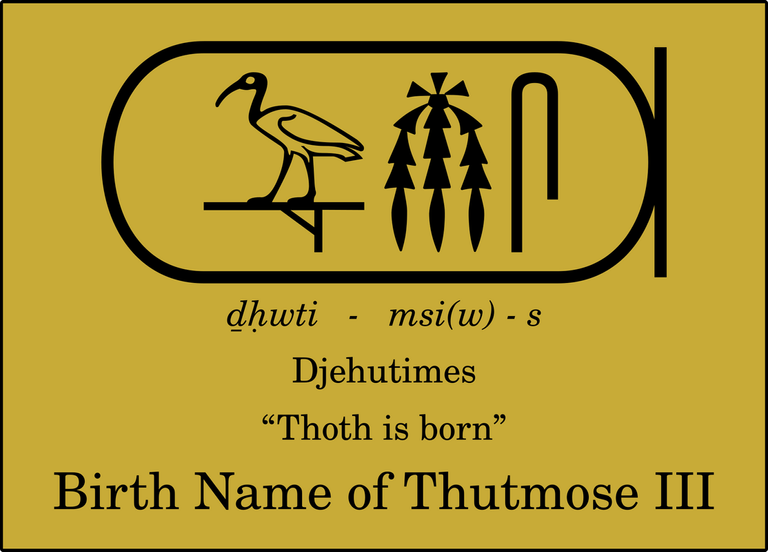
Shishak is not the only case where an Egyptian sound was transcribed by the Hebrews as shin and by the Greeks as theta. As Sweeney argues elsewhere, the Queen of Sheba refers to the female Egyptian Pharaoh Hatshepsut, who was Queen of Thebes in Upper Egypt (Sweeney 3:31 ff).
Sweeney also notes a similarity between Shishak and one of Thutmose’s titles:
One of Thutmose’s numerous titles (his Golden Horus name) was Djeser-kau, which was probably pronounced something like Shesy-ka, very close indeed to the biblical Shishak. (Sweeney 3:77)
This is all very interesting, but what about David? Returning to the Bubastite Portal in the southern wall of the great temple of Amon at Karnak, we find among a list of places in Palestine on Shoshenq’s inscription the following: h(y)dbt dwt, or the “Heights or Highlands of Dawit.” Kenneth Kitchen’s interpretation of this is strongly influenced by his identification of Shoshenq with Shishak:
Shoshenq I of Egypt had engraved at Karnak a long list of Palestinian place-names. Some of these are now destroyed, and thus lost to us; many can be readily identified with known places in Israel, Judah, the Negev, and a few in western Transjordan. But quite a few have remained obscure, Among these, in a group of names clearly located by association in the Negev/south Judah area, is “the heights of Dwt”. It could not really be Dothan―no final n, and in entirely the wrong context for a north Palestinian settlement. However, in an Ethiopic victory inscription of the early sixth century a.d. in southwest Arabia, the emperor of Axum cited explicitly passages (Ps. 65:19) from the “Psalms of Dawit,” exactly the consonants Dwt as found with Shoshenq. In Egyptian transcriptions of foreign names (both places and personal), a t could and some times did transcribe a Semitic d ... Thus there is no reason to doubt a final -d becoming a voiceless t in both Egyptian and Ethiopic (both, Afro-Asiatic languages). And no better alternative seems Forthcoming. This would give us a place-name that commemorated David in the Negev barely fifty years after his death, within living memory of the man. The Negev was an area where David had been prominent in Saul’s time (1 Sam. 24:1; 27; 30; p. 84 above). His name being in such a place-name is analogous with the “field of Abram,” also in Shoshenq’s list. So, historically, we would be within fifty years of David’s own lifetime. (Kitchen 93)
Kitchen’s reading and interpretation have had their critics, but even if we concede both, we still cannot conclude that David was a historical figure. If we move Shoshenq I to his correct place in the timeline of Egyptian history―the Persian Period―this piece of evidence no longer comes from the time of any historical David. Like the Tel Dan Stele and the Moabite Stone it merely confirms that David is not entirely a fictional construct of later scholars. The people back then believed that someone with this name had once lived. But he could just as easily have been a god or a mythical figure as a living man.
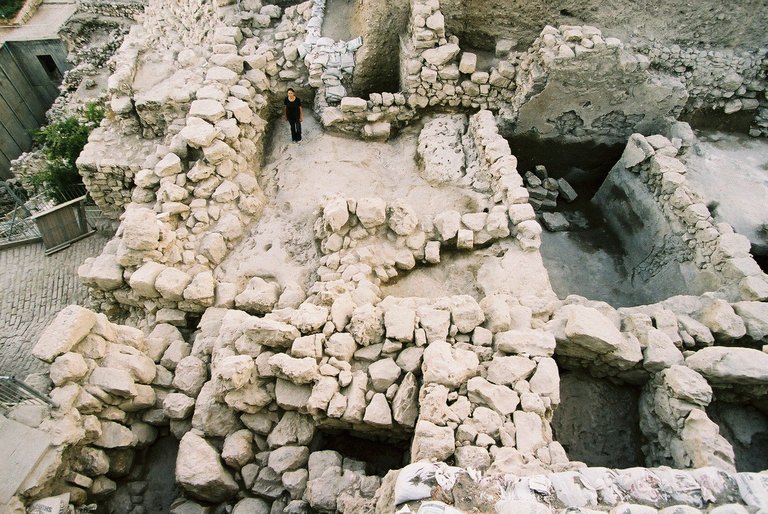
David’s Palace?
The final piece of archaeological evidence that has been adduced in support of a historical David is the so-called Palace of David, which was discovered by the Israeli archaeologist Eilat Mazar in Jerusalem in 2005. Mazar describes herself as a Biblical archaeologist of the old school:
Alongside her laptop on a paper-strewn desk sits the most telling object: a heavily marked Bible. Like her grandfather and father before her, Mazar is a believer in the Bible’s historical reliability. “One of the many things I learned from my grandfather was how to relate to the biblical text,” she says. “Pore over it again and again, for it contains within it descriptions of genuine historical reality.” She adds, “I work with the Bible in one hand and the tools of excavation in the other. That’s what biblical archaeologists do. The Bible is the most important historical source and therefore deserves special attention.”
This approach led Mazar to the site she now believes is the northern edge of King David’s palace in an area known as the City of David. When she set out on her quest in search of the palace in 1997, she turned to her Bible. She found what she was looking for in chapter five, verse 17 of the Second Book of Samuel. “When the Philistines came to fight, the Bible says David went down from his palace to the fortress,” Mazar says. “I wondered down from where? It’s very reasonable to assume that when the Bible describes David going down he came from a higher place. The only higher place is from the north.”
It was a crucial observation. Mazar reasoned the only direction where the topography is higher would be just north of the City of David, outside the walls of the Old City. She began excavating in February of 2005. The finds came quickly. Surprisingly intact, just two yards beneath ground level, were Byzantine-era artifacts, including a fully-preserved room with mosaic floors dating to the 4th to 6th centuries C.E. When Mazar peeled back the room, she uncovered water cisterns, pools and a mikvah from the Second Temple period. But it was what was under these that would prove to be the most startling. The Second Temple remains were directly on top of thick foundation walls that protruded in all directions―and even beyond―the length and width of her 30-by-10 meter excavation site. (Moment Magazine)
Mazar’s claim that the Large Stone Structure, as it is generally known, was built by King David has been hotly contested by many of her colleagues. Israel Finkelstein has been particularly scathing of her approach to archaeology:
Even more critical is Israel Finkelstein, professor of archaeology at Tel Aviv University and the leading proponent of, “low chronology,” which claims that many of the grand buildings dated to the 10th century B.C.E. and attributed to King Solomon are actually a century younger. Finkelstein characterizes the hoopla over Mazar’s discovery as “Messianic eruptions in biblical archaeology.”
In fact, Finkelstein challenges Mazar’s entire approach of linking the Bible with archaeological research. “That David took two steps down and four steps up and saw Bathsheba bathing on the rooftop does not prove that you have found King David’s palace,” Finkelstein told The Jerusalem Post. Finkelstein challenges Mazar’s entire approach of linking the Bible with archaeological research. “That David took two steps down and four steps up and saw Bathsheba bathing on the rooftop does not prove that you have found King David’s palace,” Finkelstein told The Jerusalem Post. (Moment Magazine)
Based on pottery finds, Mazar dates the Large Stone Structure to the beginning of the Iron Age II period. In the conventional chronology, this would put the structure around 1000 BCE―precisely where Biblical archaeologists place David. But in the Short Chronology Iron Age II begins in the Persian Period, the time of the Kingdoms of Israel and Judah. Even Finkelstein “low” chronology is much too high.
The Large Stone Structure was probably the palace of the Kings of Judah, whose historicity is not to be doubted: we may argue about when they reigned but not about whether they reigned. It cannot be cited as proof that David existed. Eilat’s discoveries do not include any inscriptions that mention David. Her interpretation is purely speculative.

Gunnar Heinsohn
In Die Sumerer gab es nicht [The Sumerians Did Not Exist], Gunnar Heinsohn rejected the historicity of both David and Solomon. He suggested that these two Biblical figures were originally Canaanite deities, to whom the deeds of later rulers and conquerors were attributed:
Let us turn now to the question of the Israelite conquest of Canaan, which has been difficult, if not impossible, to answer up to now. It took place at a time when the historiographical reliability of biblical traditions was increasing―that is, at the beginning of the so-called divided kingdom after about 930 BCE [in the conventional chronology]. The legends of the so-called kings of the empire, David and Solomon, may prove to be conflations of accounts of local princes and anthropomorphized astral heroes, fleshed out with historical material related to the Assyrian emperors Tiglath-Pileser III (Solomon) and Shalmaneser III (David), which later Bible compilers nostrified into ancient Hebrew history. The achievements of later Hebrew kings such as Azariah/Uzziah also seem to have been attributed to Solomon. It has long been undisputed that the terminology used to describe the territorial expansion of that great empire of David and Solomon dates back to the Persian period, i.e. the late 6th and 5th centuries BCE―indeed, it embraces the extent of the Persian satrapy of Transeuphrates [Ebir-nari]. It is still disputed as to whether an empire existed here 500 years earlier and was remembered in a way that is no longer comprehensible, or whether both the terminology and the thing described by it belong to the late period. (Heinsohn 250-251)
Gunnar Heinsohn is one of the architects of the Short Chronology, so it is not to be wondered at that I find his views aligning with mine. I consider myself one of his disciples. Note that another of Heinsohn’s disciples, Emmet Sweeney, has identified Tiglath-Pileser III with the Persian Emperor Cyrus the Great and Shalmaneser III with the Median Emperor Cyaxares II (Sweeney 4:2, 4:159).

Conclusions
There are no inscriptions from the supposed time of David. With the exception of the Tel Dan Stele and, possibly, the Moabite Stone, David is not mentioned in the annals or inscriptions of any foreign rulers. Kenneth Kitchen is satisfied that there are very good reasons for these omissions, but the simplest explanation is that was no such historical figure as David.
Moreover, if we accept the authenticity of both objects dated to the ninth century BCE (i.e., the references to the “House of David” in the Aramaic inscription on the Tel Dan stele and the Moabite one on the Mesha stele) [they] prove at most the existence―at the time when the inscriptions were written―of a dynasty claiming to be David’s descendants. Accordingly, the historicity and existence of the Davidic dynasty may be sustained safely. Nonetheless, these references afford no proof of the historicity of the alleged founder of the ruling family in Judah who might have been a purely mythical figure. (Niesiołowski-Spanò 22)
The name Dawīd may have been a title rather than a personal name. Its meaning is closely related to one of Solomon’s names Jedidiah.
David’s ancestry connects him, via Ruth, with the Moabites.
There are good reasons, then, for denying the historicity of David and identifying him with Shalem, a Canaanite god.
And that’s a good place to stop.
References
- Anonymous, Eilat Mazar: Uncovering King David’s Palace, Moment Magazine, Nadine Epstein, Washington, DC (2006)
- Michael Avi-Yonah, Ephraim Stern (editors), The New Encyclopedia of Archaeological Excavations in the Holy Land, Volumes 1, 2, 3, 4, Prentice-Hall Incorporated, Englewood Cliffs, NJ (1975)
- Joseph Campbell, The Masks of God: Primitive Mythology, The Viking Press, New York (1959)
- David Freedman (editor-in-chief), The Anchor Yale Bible Dictionary, Doubleday, New York (1992)
- Gunnar Heinsohn, Die Sumerer gab es nicht, Heribert Illig, Mantis Verlag, Gräfelfing (2007)
- Kenneth A Kitchen, On the Reliability of the Old Testament, William B Eerdmans Publishing Company, Grand Rapids, Michigan (2003)
- Michael Langlois, The Kings, the City and the House of David on the Mesha Stele in Light of New Imaging Techniques, Semitica, Issue 61, Pages 23-47, Institut d’études sémitiques du Collège de France, Peeters, Leuven, (2019)
- Łukasz Niesiołowski-Spanò, David in History and in the Hebrew Bible, Marzena Zawanowska & Mateusz Wilk (editors), The Character of David in Judaism, Christianity and Islam, Brill, Leiden (2021)
- James Orr (General Editor), The International Standard Bible Encyclopedia, Volume 2, The Howard-Severance Company, Chicago (1915)
- William Flinders Petrie, A History of Egypt, Volume 3, Charles Scribner’s Sons, New York (1905)
- Isidore Singer (managing editor), The Jewish Encyclopedia, Volume 4, Funk & Wagnalls Co, New York (1904)
- James Strong, Hebrew and Chaldee Dictionary, in The Exhaustive Concordance of the Bible, Eaton & Mains, New York (1890)
- Emmet Sweeney, Empire of Thebes, or Ages In Chaos Revisited, Ages in Alignment, Volume 3, Algora Publishing, New York (2006)
- Emmet Sweeney, The Ramessides, Medes and Persians, Ages in Alignment, Volume 4, Algora Publishing, New York (2007)
Image Credits
- David: Michelangelo (sculptor), Galleria dell’Accademia di Firenze, Florence, © Commonists (photographer), Creative Commons License
- Tel Rumeida (Hebron): © Emek Shaveh (photographer), Fair Use
- The Stepped Stone Structure (City of David): © Omerm (photographer), Creative Commons License
- David Playing the Harp for King Saul: Jan van den Hoecke (artist), Museum of Fine Arts, Budapest, Public Domain
- David and Goliath: Caravaggio (artist), Museo del Prado, Madrid, Public Domain
- The Tel Dan Stele: Israel Musuem, Jerusalem, © Gary Todd (photographer), Creative Commons License
- The Mesha Stele: Louvre Museum, ©
Henri Sivonen (photographer), Creative Commons License - The Moabite Stone (Line 31): © West Semitic Research / Michael Langlois, Fair Use
- The Bubastite Portal of Shoshenq I (Karnak): © Olaf Tausch (photographer), Creative Commons License
- Thutmose III’s Cartouche: © Peter Lundström (designer), Creative Commons License
- The Large Stone Structure: © City of David Foundation, Fair Use
- Gunnar Heinsohn: © Estate of Freud (photographer), Creative Commons License
- King David Playing the Harp: Peter Paul Rubens (artist), Barnes Foundation, Philadelphia, Public Domain

Congratulations @harlotscurse! You have completed the following achievement on the Hive blockchain And have been rewarded with New badge(s)
Your next target is to reach 650 posts.
You can view your badges on your board and compare yourself to others in the Ranking
If you no longer want to receive notifications, reply to this comment with the word
STOPTo support your work, I also upvoted your post!
Check out our last posts: